tow LOTUS ELISE 2005 Owner's Manual
[x] Cancel search | Manufacturer: LOTUS, Model Year: 2005, Model line: ELISE, Model: LOTUS ELISE 2005Pages: 205, PDF Size: 4.51 MB
Page 125 of 205
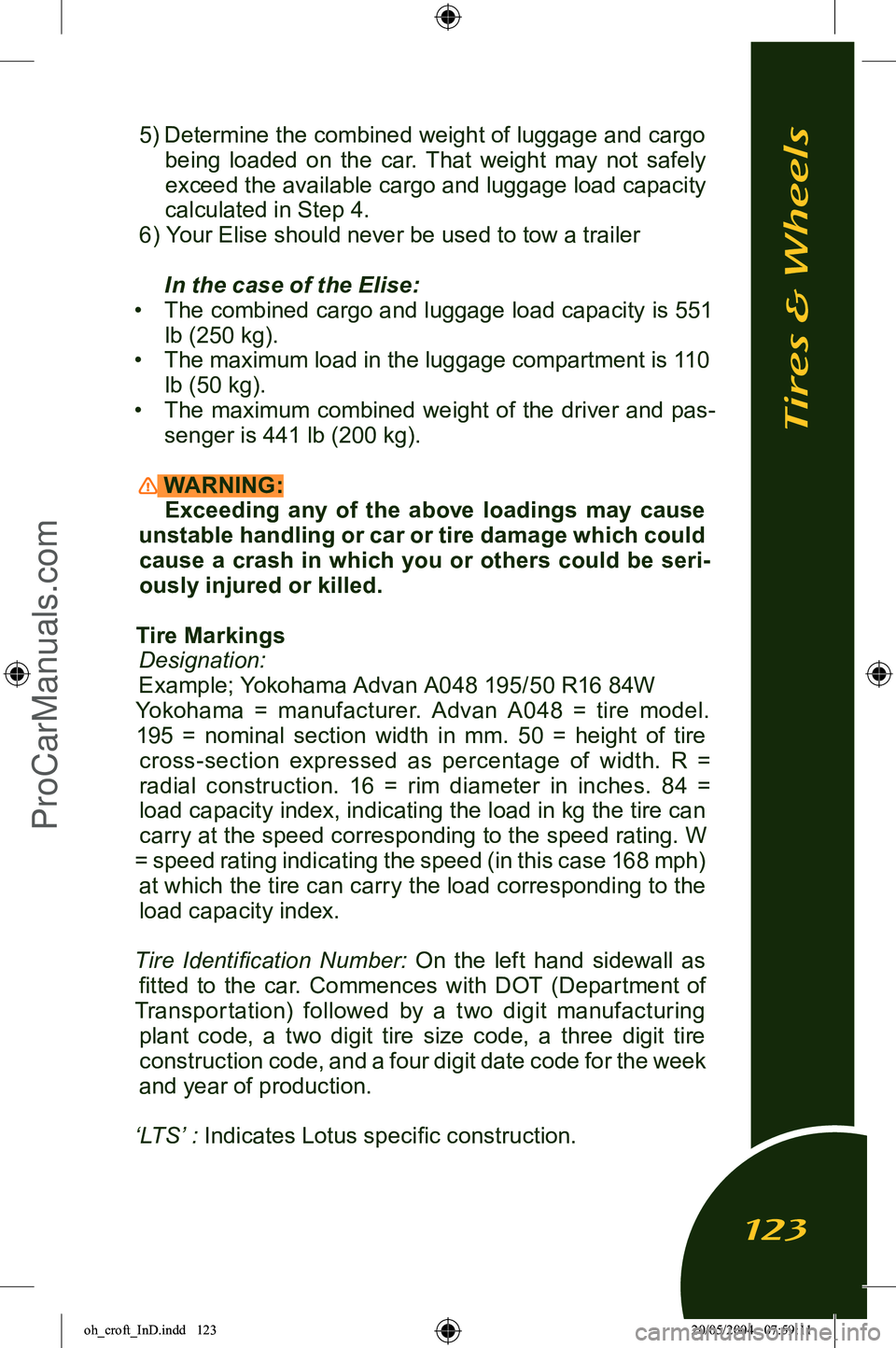
5) Determine the combined weight of luggage and cargo being loaded on the car. That weight may not safely exceed the available cargo and luggage load capacity
calculated in Step 4.
6) Your Elise should never be used to tow a trailer
In the case of the Elise:
• The combined cargo and luggage load capacity is 551
lb (250 kg).
• The maximum load in the luggage compartment is 110
lb (50 kg).
• The maximum combined weight of the driver and pas
-
senger is 441 lb (200 kg).
WARNING: Exceeding any of the above loadings may cause
unstable handling or car or tire damage which could cause a crash in which you or others could be seri
-
ously injured or killed.
Tire Markings Designation:Example; Yokohama Advan A048 195/50 R16 84W
Yokohama = manufacturer. Advan A048 = tire model. 195 = nominal section width in mm. 50 = height of tire cross-section expressed as percentage of width. R =
radial construction. 16 = rim diameter in inches. 84 =
load capacity index, indicating the load in kg the tire can carry at the speed corresponding to the speed rating. W
= speed rating indicating the speed (in this case 168 mph) at which the tire can carry the load corresponding to the load capacity index.
Tire Identification Number: On the left hand sidewall as fitted to the car. Commences with DOT (Department of
Transpor tation) followed by a two digit manufacturing plant code, a two digit tire size code, a three digit tire construction code, and a four digit date code for the week
and year of production.
‘LTS’
: Indicates Lotus specific construction.
Tires & Wheels
123
oh_croft_InD.indd 12320/05/2004 07:59:11ProCarManuals.com
Page 126 of 205
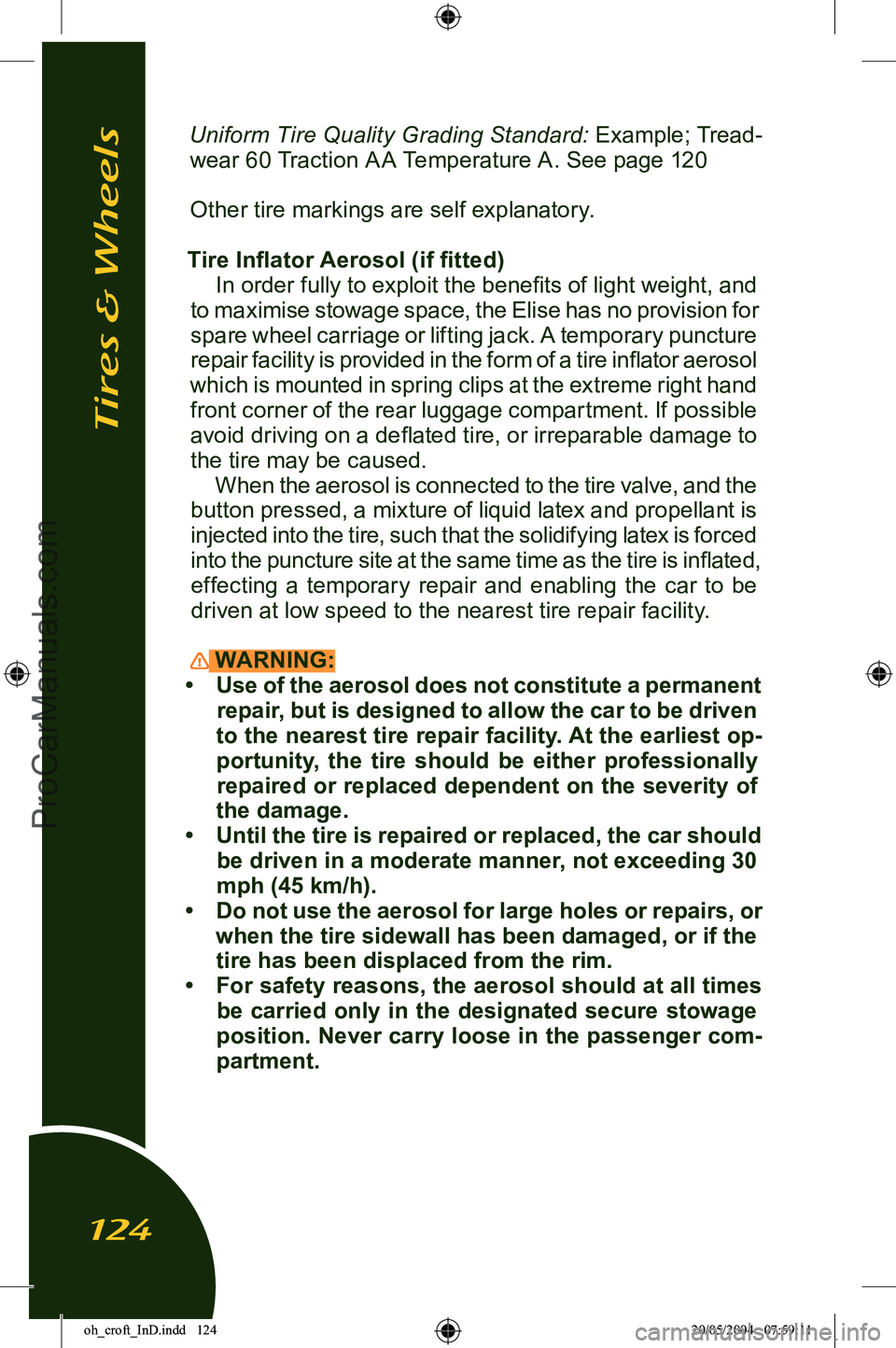
Uniform Tire Quality Grading Standard: Example; Tread-
wear 60 Traction A A Temperature A. See page 120
Other tire markings are self explanatory.
Tire Inflator Aerosol (if fitted) In order fully to exploit the benefits of light weight, and
to maximise stowage space, the Elise has no provision for spare wheel carriage or lifting jack. A temporary puncture
repair facility is provided in the form of a tire inflator aerosol
which is mounted in spring clips at the extreme right hand front corner of the rear luggage compartment. If possible avoid driving on a deflated tire, or irreparable damage to
the tire may be caused. When the aerosol is connected to the tire valve, and the
button pressed, a mixture of liquid latex and propellant is
injected into the tire, such that the solidifying latex is forced
into the puncture site at the same time as the tire is inflated, effecting a temporary repair and enabling the car to be driven at low speed to the nearest tire repair facility.
WARNING:
• Use of the aerosol does not constitute a permanent repair, but is designed to allow the car to be driven
to the nearest tire repair facility. At the earliest op
-
portunity, the tire should be either professionally repaired or replaced dependent on the severity of
the damage.
• Until the tire is repaired or replaced, the car should be driven in a moderate manner, not exceeding 30
mph (45 km/h).
• Do not use the aerosol for large holes or repairs, or when the tire sidewall has been damaged, or if the
tire has been displaced from the rim.
• For safety reasons, the aerosol should at all times be carried only in the designated secure stowage
position. Never carry loose in the passenger com
-
partment.
Tires & Wheels
124
oh_croft_InD.indd 12420/05/2004 07:59:11ProCarManuals.com
Page 128 of 205

WheelsEnsure that only original equipment, or Lotus approved wheel
and tire combinations are fitted. After the car has been used
on track, or in competition conditions, the wheels should be removed and thoroughly inspected for damage.
WARNING: After striking a pothole or kerb, the wheels should be
removed and the wheel and tire thoroughly inspected for
damage. Renew the wheel and /or tire if necessary. Safety
considerations should always be paramount and new parts
fitted in any cases of doubt.
Wheel Bolts The wheel bolts used on the Elise are of a special design to
suit the small diameter fixing tunnels in the wheel centres. The bolts have a 10 spline socket head, for which a special extension
tool is supplied with the car. A 17mm a/f deep socket and 1/2
inch square drive wrench should be applied to the extension tool,
with a tightening torque of 77 lbf.ft (105 Nm) required. To protect against wheel theft, one of the four bolts securing
each wheel is key coded, and requires a corresponding coded
socket wrench and 1/2 inch square drive extension. Rotate the coded socket until full engagement with the bolt head is ensured and take care to maintain the extension tool perpendicular to
the wheel face before applying release torque.
NOTICE: It is not recommended to use hammer action air tools on the coded bolts - use only manual tools.
Both the standard extension and coded socket tools are
stowed in the car tool kit, and should remain with the car at all
times to ensure that servicing may be performed. The key code
included in the tool kit should be recorded and kept safely with
the car documents, in case a replacement socket tool needs
to be ordered.
Wheel Alignment and Tire Balance The wheels on your car were aligned and balanced carefully
during the manufacture of your car to give you the longest tire
life and best overall performance.
Tires & Wheels
126
oh_croft_InD.indd 12620/05/2004 07:59:12ProCarManuals.com
Page 136 of 205

v) A spark will occur at the first disconnection of a jumper cable, so it is essential that the first disconnection is made from the
slave car earth. Both batteries (especially the
discharged one) will be ‘gassing’ heavily at this time, and if the first disconnection is made at a battery terminal, there is
a danger that the hydrogen gas may be ignited by the spark
with a resultant explosion.
vi) Have the cause of the flat battery investigated and rectified,
and trickle charge the battery as detailed above.
WARNING:
• Risk of damage and serious personal injury due to
shortcircuit.
• Use only jumper cables of adequate cross-section, fitted
with completely insulated alligator clamps. The cables must be long enough to allow that neither cars nor cables
touch each other.
• Follow all warnings and instructions of the jumper cable
manufacturer.
• When connnecting the jumper cables, keep them away
from engine moving parts.
• The two cars must not contact each other, or current could flow as soon as the positive terminals are connected.
• When the first clamp on each cable is connected, the other clamp on that cable must be held carefully to make sure it does not come into contact with either another cable
clamp or either car.
• Ensure that tools or metal watches or jewellery do not contact the battery terminals or live car parts.
NOTICE:
• Improper jumper cable connection can damage the alternator
and other electrical components.
• Do not attempt to push or tow start the car, as damage to the
catalytic converter or other parts could be caused.
Electrical Accessories Owners should note that the only approved extras and modi
-
fications are those which are specified by Lotus and carried out by Lotus or by an authorised dealer. Neither Lotus Cars Ltd. or
Lotus Cars Inc. accept any liability whatsoever for defects which arise from extras or modifications which are not approved by
Lotus Cars Ltd.
Electrical
134
oh_croft_InD.indd 13420/05/2004 07:59:14ProCarManuals.com
Page 148 of 205
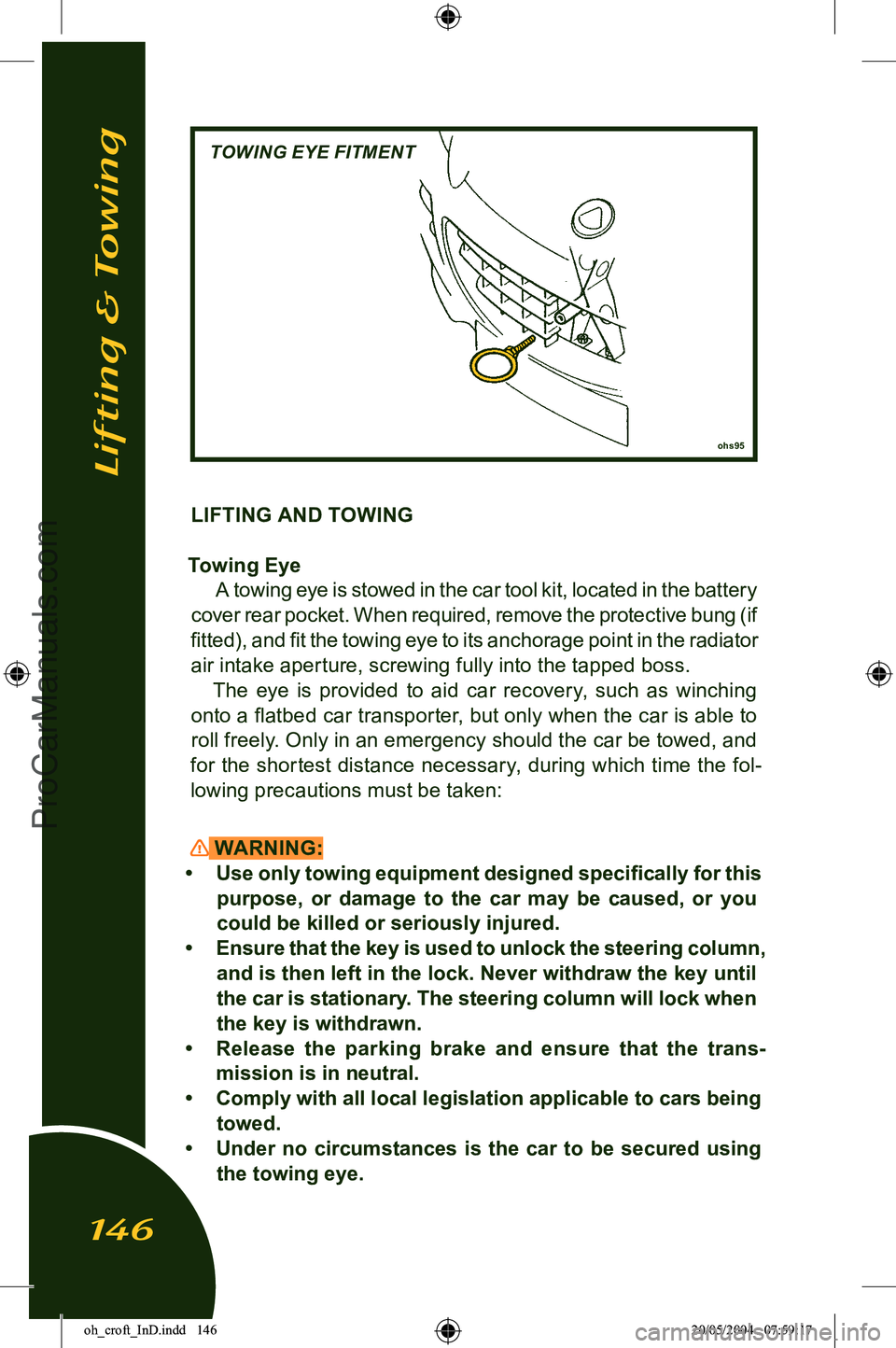
LIFTING AND TOWING
Towing Eye A towing eye is stowed in the car tool kit, located in the battery
cover rear pocket. When required, remove the protective bung (if
fitted), and fit the towing eye to its anchorage point in the radiator air intake aperture, screwing fully into the tapped boss.
The eye is provided to aid car recovery, such as winching
onto a flatbed car transporter, but only when the car is able to roll freely. Only in an emergency should the car be towed, and
for the shortest distance necessary, during which time the fol
-
lowing precautions must be taken:
WARNING:
• Use only towing equipment designed specifically for this purpose, or damage to the car may be caused, or you
could be killed or seriously injured.
• Ensure that the key is used to unlock the steering column, and is then left in the lock. Never withdraw the key until
the car is stationary. The steering column will lock when
the key is withdrawn.
• Release the parking brake and ensure that the trans
-
mission is in neutral.
• Comply with all local legislation applicable to cars being
towed.
• Under no circumstances is the car to be secured using
the towing eye.
ohs95
TOWING EYE FITMENT
Lifting & Towing
146
oh_croft_InD.indd 14620/05/2004 07:59:17ProCarManuals.com
Page 149 of 205
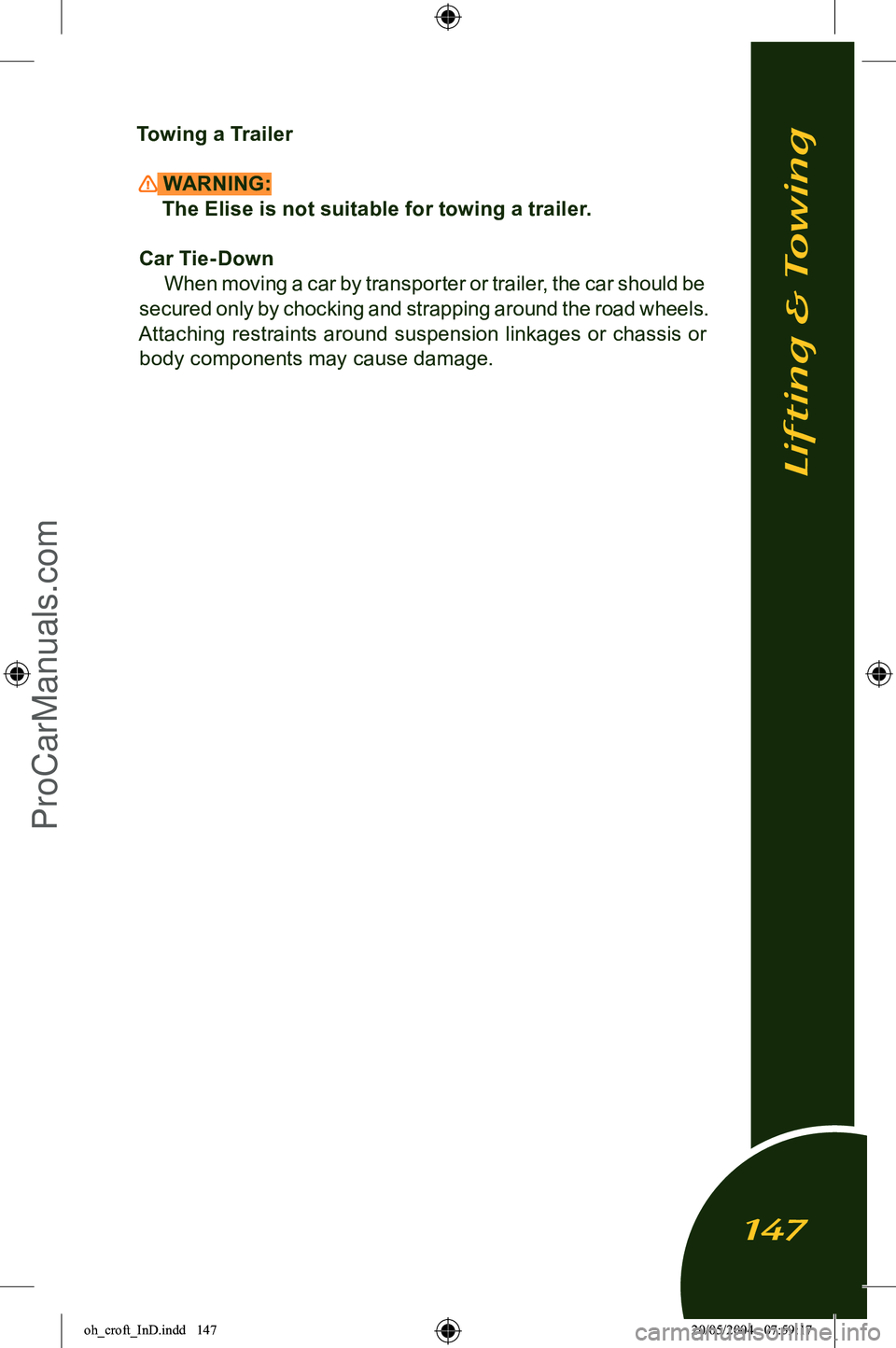
Towing a Trailer
WARNING:The Elise is not suitable for towing a trailer.
Car Tie-Down When moving a car by transporter or trailer, the car should be
secured only by chocking and strapping around the road wheels.
Attaching restraints around suspension linkages or chassis or body components may cause damage.
Lifting & Towing
147
oh_croft_InD.indd 14720/05/2004 07:59:17ProCarManuals.com
Page 150 of 205

Lifting Your Car
WARNING:
• Using a lifting jack can be dangerous. If the car falls off the jack, you or others could be seriously injured or killed.
NEVER get under a car when it is supported only by a
jack.
• Before raising the car with a jack: - Turn off the engine;
- Firmly apply the parking brake;
- Engage first or reverse gear;
- Securely chock all wheels not to be lifted.
• Use only those lifting points identified above. Jacking at any other point, or with a jack improperly positioned, may
damage the chassis or body structure and/or jeopardise safety.
Care must be taken when using a lifting jack or hoist to po
-
sition the device only in one of the areas shown in the illustration.
Use a suitable rubber or timber pad to protect the chassis from
surface damage:
A; Identified by a blue sticker. Beneath crossmember ahead of fuel tank bay. To be used one side at a time for wheel chang
-
ing - lifts both wheels on one side.
B; Garage use with 4-point lift. Beneath the front end of the right
or left hand main chassis rail, behind the front wheelarch.
ohs49
LIFTING POINTS
Lifting & Towing
148
oh_croft_InD.indd 14820/05/2004 07:59:18ProCarManuals.com
Page 151 of 205
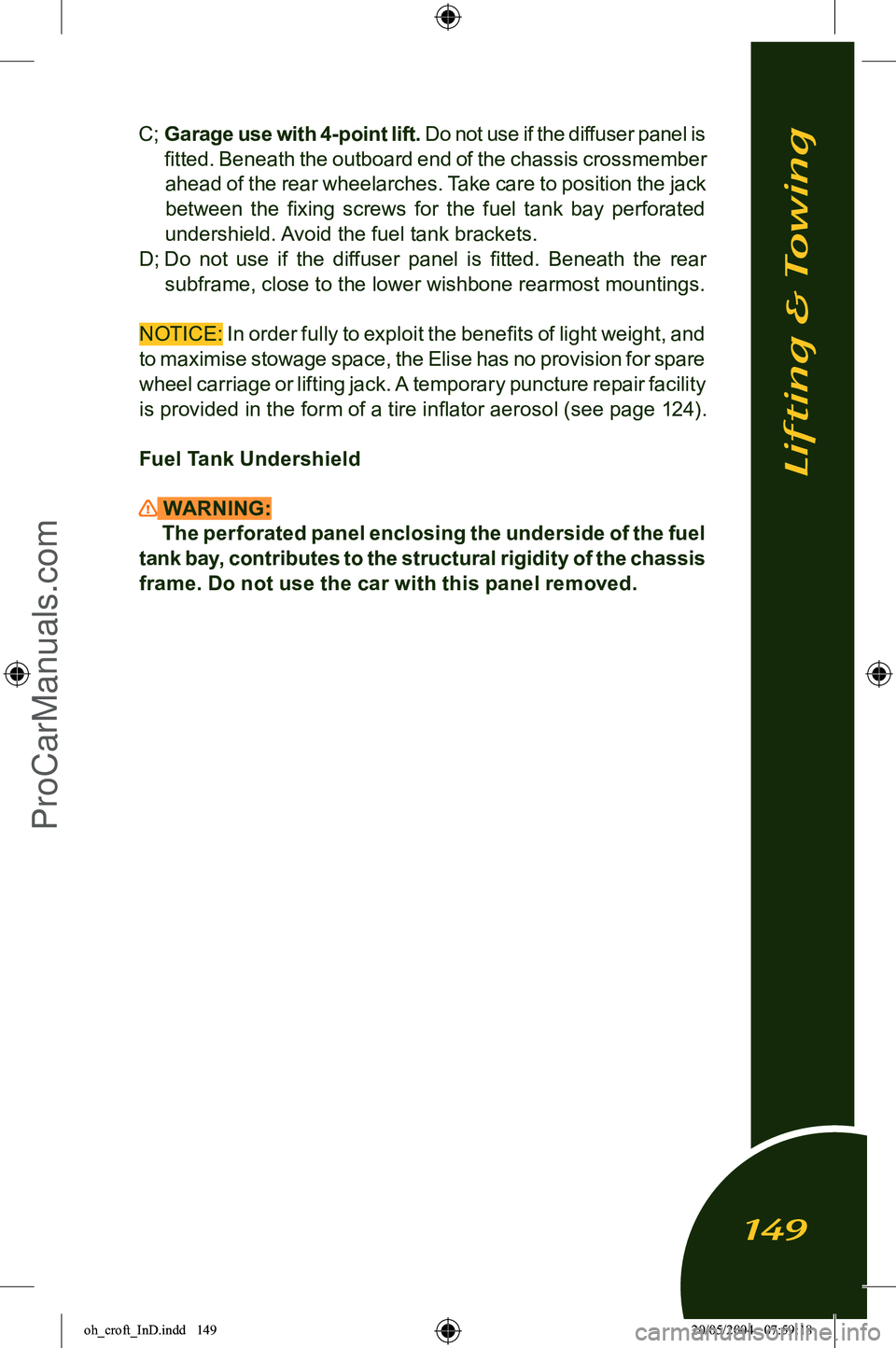
C; Garage use with 4-point lift. Do not use if the diffuser panel is
fitted. Beneath the outboard end of the chassis crossmember ahead of the rear wheelarches. Take care to position the jack
between the fixing screws for the fuel tank bay perforated
undershield. Avoid the fuel tank brackets.
D; Do not use if the diffuser panel is fitted. Beneath the rear
subframe, close to the lower wishbone rearmost mountings.
NOTICE: In order fully to exploit the benefits of light weight, and
to maximise stowage space, the Elise has no provision for spare
wheel carriage or lifting jack. A temporary puncture repair facility is provided in the form of a tire inflator aerosol (see page 124).
Fuel Tank Undershield
WARNING: The perforated panel enclosing the underside of the fuel
tank bay, contributes to the structural rigidity of the chassis
frame. Do not use the car with this panel removed.
Lifting & Towing
149
oh_croft_InD.indd 14920/05/2004 07:59:18ProCarManuals.com
Page 158 of 205

Unladen weight - total 912 kg ) inc.
(heaviest) - front 344 kg ) full fuel
- rear 568 kg ) tank
Max. weight - total 1162 kg > incl.
- front 441 kg > occupants
- rear 721 kg > & luggage
Trailer towing Not permissible
Capacities Engine oil (refill inc. filter) 4.7 U.S. qt. (4.4 litre)
(+3.7 U.S. qt (3.5) litre if front mounted oil coolers are drained) High/low dipstick mark difference 1.6 U.S. qt. (1.5 litre)
Transmission oil 2.4 U.S. qt. (2.3 litre)
Fuel tank 10.6 U.S. gall. (40 litre)
Cooling system 12.7 U.S. qt. (12 litre)
A.C. refrigerant (R134a) 1.2 lb (0.55 kg)
Front Suspension
T ype Independent. Upper and
lower wishbone co-axial
coil spring/telescopic
damper unit; anti-roll bar
Steering axis inclination 12° nominal
Geometry specification - Standard: Mid-laden ride height (reference height for geometry check)
- front 135 mm below front end
of chassis siderail
- rear 135 mm below rear end
of chassis siderail
Castor - optimum + 3.8°
- tolerance range + 3.5° to + 4.1°;
max. side/side 0.35°
Camber - optimum - 0.1°
- tolerance range + 0.1° to - 0.3°
max. side/side 0.2°
Alignment - optimum Zero - tolerance range 0.5 mm toe-out, to
0.7mm toe-in overall
Technical Data
156
oh_croft_InD.indd 15620/05/2004 07:59:19ProCarManuals.com
Page 167 of 205

cars imported into the USA which are not manufactured to a
USA specification.
(c) MAINTENANCE; SERVICE ITEMS; WEAR & TEAR.
Maintenance services are not covered , these include (al-
though this list is not exhaustive):
i) maintenance services such as tune-ups, cleaning, polishing, lubrication, wheel balancing and alignment, brake, clutch, belt
and other normal adjustments,
ii) recharging or replacement of the battery where the car is not used for prolonged periods and a battery charger is not
used,
iii) the repair or replacement of service items such as lubri
-
cants, fluids, spark plugs, wiper blades, filters, belts, hoses, brake pads and linings clutch components, light bulbs or glass,
or,
iv) after the first three months of service (unless as part of a
warranty repair), the air conditioner refrigerant, or
v) the deterioration of paintwork, upholstery (see para 5n) or any other part, assembly or component as a consequence of
normal wear and tear or exposure to the elements, including
airborne fallout (chemicals, tree sap etc.).
vi) body panel, glass and trim adjustments may intermittently be required to prevent excessive water ingress, or noise and
vibration and so should be considered as routine mainte
-
nance.
(d) INCIDENTAL AND CONSEQUENTIAL DAMAGES. UNLESS OTHERWISE EXPRESSLY PROVIDED BY LAW
THIS WARRANTY NEITHER COVERS NOR EXTENDS TO ANY INCIDENTAL OR CONSEQUENTIAL DAMAGE OR EXPENSE. SUCH DAMAGE AND EXPENSE INCLUDES
(ALTHOUGH IT IS NOT AN EXHAUSTIVE LIST) INCONVEN
-
IENCE, HOTEL OR RESTAURANT EXPENSES, TOWING
OR PARKING FEES, CAR RENTALS OR THE LOSS OF
TIME OR USE OF THE CAR.
SOME STATES DO NOT ALLOW THE EXCLUSION OR LIMITATION OF INCIDENTAL OR CONSEQUENTIAL DAM
-
AGES, SO THE ABOVE LIMITATION OR EXCLUSIONS MAY NOT APPLY.
(e) ACCIDENTS AND SIMILAR EVENTS.
Car’s malfunctions or damage resulting from accidents, col-
Limited Warranty
165
oh_croft_InD.indd 16520/05/2004 07:59:21ProCarManuals.com